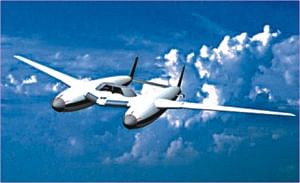Planes
to fly without fuel
What next? Spaceships to launch without engines?
By
Niloy
 Science
is advancing too fast nowadays. It seems that pretty soon we'll be
installing microprocessors in our heads so that we can in our heads
so that we can think faster, remember more, see in the dark and learn
kung-fu within minutes (think Matrix)! On the second thought, those
scary days seem to be far away. Nevertheless, science is indeed advancing
too fast. So when we hear that planes are going to be designed to
fly without fuels, we are robbed the right to be awe-struck and horrendously
bemused.
Science
is advancing too fast nowadays. It seems that pretty soon we'll be
installing microprocessors in our heads so that we can in our heads
so that we can think faster, remember more, see in the dark and learn
kung-fu within minutes (think Matrix)! On the second thought, those
scary days seem to be far away. Nevertheless, science is indeed advancing
too fast. So when we hear that planes are going to be designed to
fly without fuels, we are robbed the right to be awe-struck and horrendously
bemused.
The concept of
sustained flight without the use of fuel seems far reaching even by
today's advanced aviation standards. Even more so when you consider
that aircrafts should ideally be able to carry heavy loads of passengers
and cargo. However one innovator's astounding new invention looks
set to transform the air transport industry of the 21st Century.
Former nuclear
designer, Robert D. Hunt of Hunt Aviation Corp, has come up with an
exciting and new "gravity powered aircraft technology" that
accomplishes sustained fuel-less flight. Hunt has designed a new hybrid
of aircraft: a "gravity-powered aircraft" which is a fixed
wing, ridged skin airplane made of lightweight and modern composite
materials.
By October 2003,
Hunt Aviation Corp had already begun the first phase of prototype
construction, assembling a consortium of aviation manufacturers and
suppliers that wish to support the revolutionary aircraft technology.
Interestingly,
because this hybrid plane uses technology of gliding and aerostatic
lift, the idea for sustained flight actually has more in common with
the older technology of Leonardo Da Vinci's first primitive hang glider,
than it does from the Wright Brother's engine powered airplane only
a century ago.
The "Gravity-Plane",
as Hunt Aviation likes to call it, uses gravity's dual properties
- buoyancy which creates an upward motion in order to gain altitude,
and gravity acceleration which creates a forward and downward gliding
motion. The two motions combined form the heart of Hunt's new gravity
powered technology, a technology that will most certainly make for
a much healthier and cleaner environment.
While everyone
can understand the downward motion of the "pull of gravity",
it is buoyancy that many people do not realise is a force of gravity.
A force which when harnessed properly makes sustained flight possible.
Lighter-than-air
(Aerostatic) lift may be explained by the principal of buoyancy, also
known as the Archimedes Principal. Gravity exerts a greater pull on
more dense materials than on less dense materials, which causes buoyancy.
For example, a bubble rises in water and helium rises in air because
they are less dense than the surrounding "lifting" fluid.
In the Hunt Aviation's
"Gravity-Plane", buoyancy is created by gas bags filled
with helium within two large rigid pontoon shaped lifting bodies.
This buoyancy lifts the "Gravity-Plane" to high altitudes
to create lighter-than-air lift.
Despite it being
a better lifting gas than Helium, Hydrogen is generally not used as
a lifting gas any more because it is explosive and combustible. Inert
Helium, widely used in lighter-than-air airships, can now being used
to attain altitudes of over 100,000 feet and may be built very large
to carry heavy loads of passengers and cargo approaching 1,000 tons.
By comparison, a U. S. military C-17 heavy lifter only carries near
70 tons.
Even better than
Helium, is the idea to use a vacuum-lift system in the hybrid aircraft.
During normal operation of the aircraft, lift is provided by the vacuum
contained within rigid cells. As a precautionary measure, the new
hybrid aircraft will use a Dual-Aerostatic-Lift system that will include
the use of vacuum-lift and the use of a lifting gas. The lifting gas
is expanded into collapsible gas bags, in the event of rupture of
the vacuum-lift cell wall.
Obvious benefits
of the technology are that the aircraft does not require fuel, which
is aviation's main cost. This also makes the aircraft safer in terms
of fuel burning or exploding. Furthermore, having no waste emissions
or noise, the aircraft is extremely environmentally friendly. "Hunt's
invention is the first practical use of gravity to provide a motive
force by forming a continuous cycle out of two forces of gravity with
the result being, for the first time ever, self-sustained fuel-less
flight and this is a tremendous and historic accomplishment",
stated Gene Cox, President of Hunt Aviation Corp.
The Wright Brothers
are widely known as the pioneers of powered flight, by making a successful
flight in the first engined airplane in 1903. However, one hundred
years later in aviation's second century, it may well be that Robert
D. Hunt is seen as modern aviation's next great pioneer of "unpowered"
flight.
